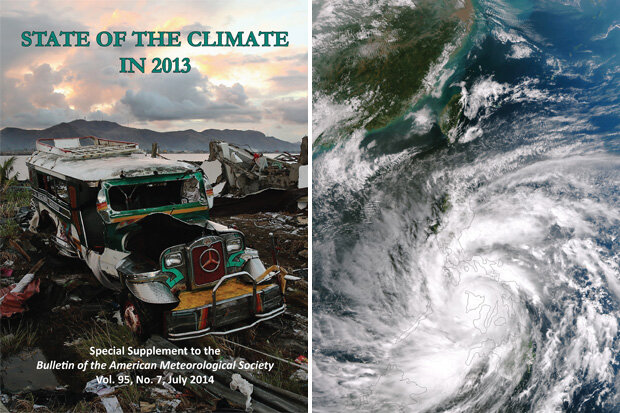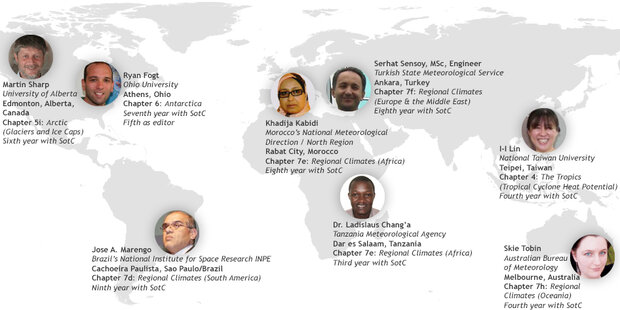State of the Climate in 2013: Spotlight on authors
As the assessment now known as the BAMS State of the Climate report pushes well into its third decade, the level of international participation is at an all-time high. More than 420 authors from institutions in 57 countries contributed to this year’s report. This kind of diversity ensures that a range of scientific disciplines, including atmospheric scientists, tropical meteorologists, oceanographers, and glacier experts, examine the climate system.
It also helps strengthen international data sharing and showcases a number of innovative ways to analyze and display data. Most importantly, it underscores that the climate we live in is not only shared around the world, but also that it affects different people in different places in different ways. Here is a snapshot of some of the contributors to the State of the Climate in 2013.

Front and back cover of State of the Climate in 2013 from the American Meteorological Society. Full report.

A handful of the 425 authors who contributed to State of the Climate in 2013.
What is your role in understanding and analyzing climate?
- Jose Marengo: I am a senior climatologist at INPE, working with seasonal climate prediction, extremes, climate change, and natural disasters.
- Ladislaus Chang’a: Weather and climate information are crucial for planning various socioeconomic activities and can be effectively used to alleviate or lessen the impacts of climate change and hazardous weather events such as tropical cyclones, floods, and strong winds. My agency has a responsibility to collect, ensure data quality, and archive weather and climate data. We prepare tailor-made products and publications to meet various needs.
- Serhat Sensoy: I prepare monthly, seasonal, and annual climate assessments, climate classifications, climate indices, and heating and cooling degree day analyses. I contribute to annual climate reports of the World Meteorological Organization and BAMS. I prepare climate monitoring, seasonal climate forecasts, climate data, and climate watch products for the Eastern Mediterranean Climate Center.
How does your work inform the big picture of what we know about the climate?
- Khadija Kabidi: Understanding and analyzing climate allows us to take the necessary measures in the right time to, first, sensitize the population and to, second, mitigate negative impacts on different socioeconomic sectors.
- I-I Lin: I am a specialist on tropical cyclone and ocean interaction. My work helps us understand how the overall state of the climate and its changes can influence the ocean’s heat reservoir, which fuels tropical cyclone intensification, especially in super typhoons.
- Jose Marengo: My work helps in identifying and studying extreme weather and climate events throughout South America, both related to natural climate variability and anthropogenic influences, as well as natural disasters related to those extremes.
- Serhat Sensoy: Our contribution to the State of the Climate report is part of the global picture that fits into the “Country Spotlight” or “Regional Climate” sections. This work contains temperature and precipitation anomalies and extreme events that occurred in the region. These kinds of climate information are very important for respective users in the health, agriculture, water, and disaster-risk reduction sectors.
How is the climate important to your part of the world (or the phenomena you study)?
- Khadija Kabidi: Climate study is highly important for our region. Indeed, with the climate change issues facing the world, which the Intergovernmental Panel on Climate Change’s fifth report has confirmed, understanding climate becomes a necessity, especially in terms of rainfall, temperature, and extreme events.
- Ladislaus Chang’a: Tanzania has strong spatial and temporal rainfall variability. In recent years, the frequency and magnitude of extreme weather and climate events, particularly droughts and floods, have increased, causing severe socioeconomic impacts. About 80% of the population lives in rural areas, depending on rain-fed agriculture for their livelihoods. Electricity generation is, to a large extent, still dependent on availability and distribution of rainfall. Therefore, climate is a very important factor for socioeconomic development and the livelihoods of people over the entire East African region.
- I-I Lin: It is truly important. I study the interaction between super typhoons and the ocean, which impacts a billion people across the Asia–Pacific region. The climate state of the Pacific, including its interannual variability, greatly impacts both the typhoons and the people in this region.
- Martin Sharp: We study changes in the mass of glaciers and ice caps in the Arctic, how they are related to the changing climate, and how they affect global sea level. In cold, dry regions like Arctic Canada, most of the mass variability is related to changes in summer temperature, while in more maritime regions like southern Alaska, changes in winter precipitation play a big role.
- Ryan Fogt: Antarctica has one of the harshest climates globally, with large swings especially between summer and winter. Understanding climate in Antarctica is paramount in order to better understand global sea level changes, ozone depletion, and the impacts on some unique ecosystems.
- Serhat Sensoy: The Mediterranean Basin is the one of the areas that will be affected most by the negative effects of climate change. Increasing temperature, decreasing rainfall, more drought and floods, more heat waves, and sea level rise are major threats for the region.
- Skie Tobin: Australia has one of the most variable climates in the world along with vastly different climatic regimes across our rather large continent. Much of that variability, particularly in terms of rainfall, is driven by cycles of El Niño and La Niña in the Pacific Ocean, so we watch that very closely. Recent examples of swings in that pattern have seen extensive flooding (and our wettest two-year period on record!) in 2010–12 and widespread drought in 2006.
How did the climate of 2013 affect your part of the world (or phenomena you study)?
- Jose Marengo: We had an intense flood in Amazonia, a drought in Northeast Brazil that started in 2012, and rainfall extremes in southeastern South America that produced urban floods and landslides in large cities such as Sao Paulo and Rio de Janeiro.
- Khadija Kabidi: Heavy rainfall caused by severe perturbations during winter and spring led to serious damage. Several convective systems also impacted the summer season, inducing floods in just a few minutes.
- Ryan Fogt: August–October 2013 were particularly interesting in Antarctica—during this period, sea ice surrounding Antarctica reached another record maximum, and temperatures at the South Pole reached a new record high. Increasing sea ice over the last few decades, in particular, has created a few logistical problems with ships reaching the main U.S. base, McMurdo. It also stresses some penguin colonies that have to travel farther to reach the ice edge.
- I-I Lin: In November 2013, super typhoon Haiyan (170 kts, or 196 mph) became one of the most intense tropical cyclones ever observed globally in recorded history. It was 35 kts (40 mph) above the category 5 intensity threshold. Haiyan devastated the Philippines. The death toll has exceeded 5,000, with great socioeconomic impacts.
- Skie Tobin: It was hot. Temperatures were persistently warm for most of the year, and we sweltered through a number of record heat waves. Indeed, 2013 was the hottest year on record for Australia with a mean temperature anomaly of +1.20°C (2.16°F), clipping the previous hottest record (2005) by almost two-tenths of a degree. Both maximum and minimum temperatures were well above average for most of Australia and were highest on record for large parts of inland and southern areas.
How do you use the State of the Climate report after it is published?
- Jose Marengo: I use it as a reference for studies and articles, presentations, and for teaching activities and lectures.
- Ladislaus Chang’a: Once published, I use it for enhancing my knowledge and for teaching by reading and extracting illustrations and new findings for my Master’s students working in climate and climate change related subjects.
- I-I Lin: I will read the report and discuss it with my students. I also send it to colleagues in the field because it provides a very good summary of each year’s climate state and covers different dimensions in the earth’s climate system, including tropical cyclones and the ocean, atmosphere, and climate.
- Martin Sharp: I use the report to get a broader perspective on what climate is doing across all glaciated regions of the planet and how the Arctic fits into the bigger picture. I also use it to see how the climate trends and changes that affect glacier mass impact other elements of the cryosphere like seasonal snow cover, permafrost, and sea ice.
What parts of the State of the Climate report, outside your own, do you really look forward to reading?
- Martin Sharp: The sections on atmospheric circulation and trends in air temperature and precipitation in the Arctic are especially valuable for us because they provide the context to explain the changes we see in glacier mass. The section on Greenland is also important because it helps to complete the picture of what is happening to all land ice in the Arctic.
- Skie Tobin: Like many of my colleagues working in climate across the world, I’m a bit of a weather nut, so I always love reading about the dominant climate influences in other geographic regions during the year. We usually hear about the more dramatic or damaging weather events at the time they occur in media coverage, but the collated information including the underlying causes is invaluable.